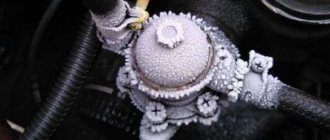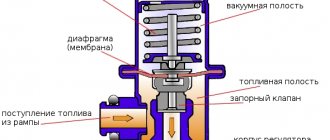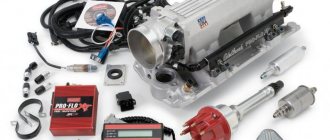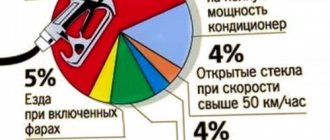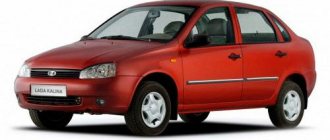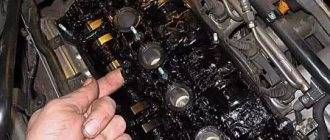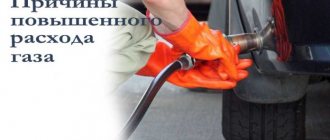My VAZ 2114 (1.5) 2005 with a mileage of 104 thousand uses about 12 liters per hundred in the city, but it’s still November, so what can we expect in winter? But my father’s 14th with a 1.6 engine consumes a stable 8.1 liters per 100 km in the city. And I asked myself: “Why is the fuel consumption so high on my 2114?” And I went looking for an answer on the Internet, as a result of which this article was created
According to the passport, Samara-2 should consume 7.6 liters per 100 km in mixed mode, in the city - no more than 9 liters. If your readings are as high as mine, then it's time to address the increased fuel consumption.
The reason for the high consumption of gasoline, both in VAZ and in other cars, may be the engine management system: it includes an Electronic Control Unit ( ECU , popularly known as the “brains”) and various sensors and drive mechanisms.
Checking the entire engine management system is quite difficult, and it is better to entrust this work to professionals, but if you want to solve the problem yourself, then go for it. Check the mass air flow sensor: Read the article How to check the mass air flow sensor on a VAZ?
The cause of increased fuel consumption can also be a faulty fuel system, namely the fuel pressure in the fuel system (How to check the pressure in the fuel system?):
- Clean/replace the fuel injectors (Cleaning fuel injectors. 4 ways/ How to remove injectors?).
- Replace the fuel pump.
- Replace the fuel filter (Replacing the VAZ fuel filter).
- DS is faulty.
- The phase sensor (PF) is faulty.
- The oxygen sensor (Lambda probe) dies.
- A clogged air filter will increase your fuel consumption by about 3 liters. So it’s better to replace it once again; it costs about 120 rubles. How to replace the air filter?
It also doesn’t hurt to check the following elements:
Increased gasoline consumption may be due to low compression in the engine (How to measure engine compression correctly?). Consumption is also affected by an incorrectly set ignition angle and incorrect valve timing.
At worst, check the tire pressure, they also affect fuel consumption. (What pressure should be in the tires of a car?)
Why did the fuel consumption of the VAZ-2115 become high?
First of all, I would like to draw attention to the fact that the amount of fuel consumed by a car depends on many factors that are easy to eliminate. Therefore, if gasoline has started to disappear somewhere in your VAZ-2115, first of all pay attention to:
- fuel quality;
- tire pressure (must always be adjusted correctly);
- driving style (driving at too high speeds or driving with unexpected acceleration leads to excessive fuel consumption);
- engine temperature (if you drive with a cold engine, gasoline consumption will be much higher than when the engine reaches its operating temperature).
But, besides this, the high fuel consumption of the VAZ-2115 may also indicate that it has some technical malfunctions. Their signs:
- black smoke from their exhaust pipe, the amount of which increases sharply when you press the gas pedal;
- the engine “troubles”, the car drives jerkily and cannot gain a sufficient number of revolutions;
- the engine runs smoothly, but it seems that it lacks power;
- popping noises are heard in the intake manifold or muffler;
- The Check Engine light came on on the dashboard.
Fuel consumption in various conditions
The most important factors showing actual fuel consumption are the operating conditions of the vehicle. If you are driving on the highway, the car will consume a slightly smaller amount of fuel compared to driving around the city. In addition, weather conditions also play a major role. In winter, gasoline costs will differ from summer. So, let's look at the indicators for various operating conditions and weather.
So, if you plan to drive frequently on highways, your car will need the following amount of fuel:
- in the hot season - 7 l;
- in frosty weather - 7.7 l.
The stated figures differ from the official ones. AvtoVAZ assumes only 6 liters for a trip on the highways. In reality, the consumption differs by 1-1.7 liters.
If your car will be driven in the city, you should pay attention to the following indicators:
- in the hot season 9.2 l;
- in cold weather - 10.6 l.
Here, we can say, the manufacturer did not disappoint with its promises. Initially, it was stated that the Lada-2114 would consume approximately 10 liters of fuel in the city. Reality shows that this is approximately how it turns out.
It is also necessary to pay attention to the mixed fuel consumption when operating in different conditions. The average values in this case will be as follows:
- in the hot season - 8.3 l;
- in cold weather - 8.8 l.
AvtoVAZ assumed that the Lada-2114 would “eat” approximately 7.6 liters in such conditions. In principle, here we can also say that the manufacturer did not deceive. The difference between summer fuel costs and the average value stated by the manufacturer is not too different. In winter, the car consumes a little more fuel, which, in general, is quite natural.
At the same time, we again have to state the fact that AvtoVAZ failed to create an economical car. It’s difficult to say whether they aimed for this, but in general, the consumption of the Samara manufacturer’s products is disappointing. Modern European small cars can boast of five liters per hundred kilometers, while the Lada-2114 is not yet capable of exceeding the 7 liter mark. Although compared to other domestically produced cars, this is already considerable progress.
It is difficult to say unambiguously what the real fuel consumption is on the Lada-2114. Too many factors provoke “error”. For example, it is also important to remember the octane number of the fuel used and its quality. AI-95 gasoline will go away more slowly than AI-92, which is quite natural. Low quality fuel will cause increased consumption. The technical condition of the car is also important. This indicator will be individual for each car enthusiast, but it is unlikely that it will deviate greatly from the values given in the article.
Causes of excessive fuel consumption
The reasons for all of the above can be a wide variety of vehicle malfunctions.
For example, black smoke from the exhaust pipe may indicate the following problems:
- the engine control unit is not configured;
- the injectors are clogged;
- spark plugs require replacement;
- air flow sensor is faulty;
- The air pressure regulator creates excessive pressure in the fuel system;
- The camshaft position sensor is faulty.
If the operation of the VAZ-2115 engine is unstable, the reasons may be as follows:
- The idle speed control does not work;
- the exhaust valve on one of the cylinders is burnt out;
- high-voltage wires require careful inspection;
- compression in the cylinders is too weak;
- The piston group requires repair;
- some defects have formed in the ignition coil;
- air is drawn in through the intake manifold.
When the engine runs smoothly, but the car drives poorly, and there is increased gasoline consumption, the following reasons are possible:
- the brake system is faulty (for example, the handbrake may not be adjusted or the brake cylinder may be jammed);
- the air filter is clogged;
- delayed ignition is installed on the engine control unit;
- the catalyst is clogged or the oxygen sensor is faulty;
- The car tank has been filled with gasoline with too low an octane number or contains unnecessary impurities.
Reasons for high fuel consumption on VAZ
My VAZ 2114 (1.5) 2005 with mileage of 104 thousand. consumes about 12 liters per hundred in the city, but it’s still November, so what can we expect in winter? But my father’s 14th with a 1.6 engine consumes a stable 8.1 liters per 100 km in the city. And I asked myself: “Why is the fuel consumption so high on my 2114?” And I went looking for an answer on the Internet, which is why this article was created =)
According to the passport, Samara-2 should consume 7.6 liters per 100 km in mixed mode, in the city - no more than 9 liters. If your readings are as high as mine, then it's time to address the increased fuel consumption.
- The reason for the high consumption of gasoline, both in VAZ and in other cars, may be the engine management system: it includes an Electronic Control Unit (ECU, popularly known as the “brains”) and various sensors and drive mechanisms.
Checking the entire engine control system is quite difficult, and it is better to entrust this work to professionals, but if you want to solve the problem yourself, then go for it:
2. The cause of increased fuel consumption can also be a faulty fuel system, namely the fuel pressure in the fuel system (How to check the pressure in the fuel system?):
3. A clogged air filter increases your fuel consumption by about 3 liters. So it’s better to replace it once again; it costs about 120 rubles. How to replace the air filter?
It also doesn’t hurt to check the following elements:
4. Increased gasoline consumption may be due to low compression in the engine (How to correctly measure engine compression?). Consumption is also affected by an incorrectly set ignition angle and incorrect valve timing.
5. At worst, check the tire pressure, they also affect fuel consumption.
High consumption at idle speed
Consumption at idle speed should be 0.8-1 liters per hour with electrical equipment turned off. If your readings are much different, then pay attention to the following sensors:
High fuel consumption on a carburetor engine, what to do?
In principle, owners of carburetor nines need to pay attention to the problems listed above, with the exception of the engine management system - it does not exist as such. Also, don’t forget about the carburetor itself, adjust it.
Reference
Note that the passport and real fuel consumption of the VAZ-2114 are different things. And these parameters rarely coincide. The manufacturer claims that the gasoline consumption of the VAZ-2114 with a 1.5-liter engine is 6.8 liters in the combined cycle per 100 km. When driving in the city, the car consumes 8.9 liters, and on the highway – 5.2 liters.
There is also a car with a 1.6-liter engine, the consumption of which is slightly higher - 7.2/5.4/9.8 liters in mixed driving mode, on the highway and in the city, respectively. These figures, according to the manufacturer, are quite attractive. Judging by them, we can conclude that the car is quite economical.
However, driver reviews regarding the fuel consumption of the VAZ-2114 (Lada) indicate that the car consumes more fuel. Most car owners indicate the following figures:
- With a 1.5-liter engine in the city, the car “eats” 12 liters of gasoline per 100 kilometers. With a 1.6-liter engine in the city, consumption increases to 13.5 liters.
- On the highway, cars with both engines consume 5.5-6 liters.
- In mixed mode, consumption is in the range of 7.5-8 liters per hundred.
Many owners of these cars have even higher fuel consumption, but in this case there are malfunctions with the engine or some elements of the fuel system.
Reasons for increased fuel consumption on the VAZ 2114
How to reduce fuel consumption on a VAZ 2114 is a question many car enthusiasts ask. What the gasoline consumption of a VAZ 2114 should be is usually indicated in the factory documentation. It ranges from eight to nine liters per hundred kilometers. This spread depends on the driving style and its mode (city, highway, mixed). If the indicators of your iron “favorite” fit into these frameworks, then most likely no intervention will reduce them. But if your VAZ 2114 has high fuel consumption, then this is already a reason to carry out diagnostics and most likely repair the systems of your car.
If you yourself do not have sufficient knowledge or skills, then it is better for you to contact specialized workshops where they will accurately answer the question: why the fuel consumption on the VAZ 2114 has increased.
Here we will talk about possible causes and methods for eliminating them.
Reasons for high fuel consumption on the VAZ 2114
Next, we will find out which sensors affect fuel consumption.
The lambda probe assesses the state of the exhaust (the presence of oxygen in the exhaust gases). That is, based on the volume of oxygen in the exhaust, it provides adjustment of the working mixture. It is installed in the exhaust system, it should be noted that it is the only one located on the “pipe” so you can’t go wrong. An oxygen sensor error can be seen either using the on-board computer or when undergoing diagnostics at a service station. Here are some reasons for his “death”:
- Poor quality gasoline;
- Stiff valves;
- Incorrect mixture;
- Oil scraper rings allow oil to flow into the mixture;
- The advance angle is incorrectly set.
Increased consumption in idle mode
Does the VAZ 2114 have higher fuel consumption at idle? Sensors monitor everything here too! Normal consumption, with the electrical load completely turned off, is 0.8-1 liter per hour. If this indicator is greatly exceeded on your car, then we check the sensors described below.
Idle speed sensor (ISR). Its purpose is to automatically adjust idle speed. It is located on the throttle assembly, or rather secured with a pair of screws on its cover. This sensor does not have an electronic diagnostic system and therefore its condition can only be judged by these signs:
- When starting a cold engine, high speeds are not observed;
- The engine stalls at idle;
- Idle speed “floats”;
- When you turn off the speed while driving, the gearbox stalls.
Idle speed regulator VAZ 2114
TPDZ. A device for precise dosing of the mixture or, more simply, a throttle valve location sensor. By its name you understand that its function is to “show” to the controller what position the throttle valve is currently in. It is part of the throttle assembly and is attached to its body. The malfunctions of this device are very similar to the symptoms of DXX, but it is connected to an electronic diagnostic system and if it breaks down, the “check” light will notify you about it.
In addition to all the above reasons, there are some more: insufficient compression in the engine, incorrectly set ignition timing, the gas distribution system is not adjusted, defective spark plugs, breakdown of high-voltage wires. These reasons can also negatively affect the average fuel consumption of the VAZ 2114.
If you feel the strength to eliminate them, then go ahead! If you have doubts about this, it is better to contact a specialized service center, this will help to avoid unnecessary costs.
The VAZ 2114 is considered a fairly economical car in terms of fuel consumption, but actual gasoline consumption does not always coincide with factory standards. And sometimes fuel consumption increases so noticeably that the question involuntarily arises - what is the reason and what needs to be done so that the norm comes into line with the factory settings or at least approaches them.
Increased gas mileage – directly related to your budget
Lambda probe
A lambda probe is a sensor that evaluates the state of exhaust gases and determines the presence of oxygen in it. This sensor is located in the exhaust pipe, and it may well affect gasoline consumption. If the lambda probe is faulty, fuel consumption will increase, because the system will not be able to accurately regulate the mixing of gasoline and oxygen.
However, if the sensor fails, the “Check” light on the instrument panel lights up. If it doesn’t light up, and the fuel consumption of the VAZ-2114 per 100 km still remains high, then the problem is clearly not there. When the “Check” light appears, you need to read the error code, which will most likely confirm a sensor malfunction, but not a fact.
FACTORY SPECIFICATIONS
In any case, the fuel consumption of the VAZ 2114 per 100 km depends on the operating conditions of the vehicle. This indicator also affects the characteristics of the engine. It must be taken into account that the VAZ model was equipped with 4-cylinder engines:
- Volume 1.5 liters, 8 valves;
- Volume 1.6 liters, 8 valves;
- Volume 1.6 liters, 16 valves.
Table of gasoline consumption per 100 km. (according to data from the car manufacturer VAZ)
Therefore, the fuel consumption of a VAZ should differ slightly according to factory conditions in different modes, depending on the displacement of the engine and the number of valves in the cylinder head.
8kl engine 11183 1.6 l MT 82 hp
In the 2nd half of the 2000s. VAZ specialists have modernized engines designed for front-wheel drive Lada cars. An increase in displacement by 100 cm³ led to an increase in maximum power by 5 hp. while improving the elasticity of the engine. The design began to use an injector with Russian-made components, the catalytic converter was moved closer to the exhaust manifold, which made it possible to reduce the amount of harmful emissions during engine warm-up.
Some cars with engine 11183 have a power of 81 hp. due to the use of a different software version in the engine control unit. The average fuel consumption rate for the VAZ-21144 declared by the plant has increased to 7.6-7.8 liters per 100 km (depending on the year of manufacture of the car). When operating on highways at a speed of 90 km/h, the engine burns 6.0 liters of fuel; in urban conditions, the “appetite” increases to 10.3 liters per 100 km. To fill the fuel tank, A-95 grade gasoline is used (A-92 is allowed as a temporary replacement).
To reduce fuel consumption, it is practiced to install gas equipment with nozzles for injecting fuel into the manifold. The toroidal reservoir is installed in the spare wheel well, so you need to carry a first aid kit with you to repair punctured tires. In urban conditions, the car requires about 11 liters of gas per 100 km; on the highway, consumption drops to 8 liters. Car owners note that incorrect adjustment of equipment leads to increased gas consumption and unstable operation of the power unit.
REAL PETROL CONSUMPTION ON VAZ MODELS
Real fuel consumption on the VAZ 2114 (as well as on the VAZ 2113 and 2115) often differs from the factory values. Mainly differs in the direction of increase. Of course, a lot depends on weather conditions. In winter, due to long and frequent warm-ups of the car, gasoline consumption increases, and other factors also influence fuel consumption:
- Driving style. Driving with sudden acceleration and high speed does not save fuel;
- Various malfunctions: in the engine, in the ignition system, in the fuel system, etc.;
- Unregulated tire pressure;
- Driving on a cold engine;
- Fuel quality.
How much fuel does the VAZ 2114 consume?
Fuel consumption on the VAZ 2114 directly depends on what type of engine the car is equipped with.
The following engines were installed on this car model:
- VAZ 2111 – volume 1.5 liters. Its fuel consumption per 100 km was 9-10 liters in the urban cycle, about 5 liters on the highway, and 6.2 liters in the combined cycle.
- VAZ 21114 - with an increased volume of 1.6 liters. It consumed 5.4 - 5.5 liters of fuel per 100 km on the highway, about 10 liters in the city, and 7.2 liters in mixed mode.
- VAZ 21124 – volume 1.6 liters, 16-valve. With a mixed cycle, its consumption was 7.6 liters. In the city, actual consumption was about 8 liters per 100 km, on the highway - about 6-7 liters.
Thus, fuel consumption depends not only on the type of engine, but also on its operating mode and specific efficiency. In general, real gasoline consumption indicators are almost no different from those declared by the manufacturer.
The following factors also influence the level of gasoline consumption:
- driving style - when driving fast, the actual consumption is much higher than that stated by the manufacturer;
- engine warm-up level – consumption increases when the engine is not warmed up;
- incorrect adjustment of tire pressure levels;
- low-quality fuel - with impurities or low octane number;
- time of year - as a rule, consumption is higher in winter.
It is very important to use only the type of fuel recommended by the manufacturer. For VAZ 2114 this is 95th gasoline. Gasoline with a low octane number consumes more and can lead to various breakdowns of the fuel system.
INCREASED CONSUMPTION, WHAT TO DO
Let's look at the main points that car owners face.
SIGNS
Consumption of fuel above the norm is a phenomenon that occurs quite often. Therefore, many car owners are often interested in how to reduce fuel consumption on a VAZ 2114. If the driving style does not raise any doubts in terms of accuracy, and it’s summer and the roads are smooth, then you need to pay attention to the technical condition of the car to see if this is the reason. High fuel consumption may be accompanied by the following symptoms:
- There is black exhaust coming from the muffler pipe. It is most noticeable when you sharply press the gas pedal;
- The engine runs unsteadily (troits), does not develop speed, the car drives jerkily;
- The motor runs smoothly, but is “dull” and lacks power;
- Popping sounds in the muffler or intake manifold;
- The Check Engine diagnostic light is on inside the car.
Check Engine light on
CAUSES
The reasons for high fuel consumption can be so different that a simple car enthusiast will most likely be able to understand only the most standard and simple cases. Often many signs are interrelated. For example, black smoke from the exhaust pipe may be accompanied by popping noises.
Black smoke indicates the fuel mixture is too rich. Causes:
- The settings of the engine control unit are lost;
- Nozzles are clogged;
- Spark plugs are faulty;
- The MAF (air flow sensor) is acting up;
- The fuel pressure regulator creates excess pressure in the fuel system;
- The camshaft position sensor does not work.
High fuel consumption of the VAZ 2114, accompanied by unstable engine operation:
- The idle speed controller has failed;
- The exhaust valve in one of the cylinders burned out;
- High-voltage wires are faulty;
- Weak compression in the cylinders, the piston group requires repair (replacement of piston rings, boring of cylinders);
- There are defects in the ignition coil;
- There is air leakage through the intake manifold.
It would seem, how can there be increased fuel consumption when the fuel mixture is obviously lean during suction? The thing is that the proportion of air and fuel must still be observed. And more air requires more gasoline.
The engine runs smoothly, but the car drives poorly, and the fuel quickly disappears from the tank:
- Malfunctions in the brake system (the working brake cylinder is jammed, the handbrake is not adjusted).
- The air filter element is clogged.
- Retarded ignition is set on the engine control unit.
- The oxygen sensor is faulty, the catalyst is clogged.
- The tank is filled with gasoline with a low octane number, or the fuel contains unwanted impurities (for example, water).
Protect your car from low-quality fuel - refuel only at proven gas stations
Sometimes there are such cases that it takes a long time to guess why fuel consumption has increased and the car does not drive. Let’s say, this is an interesting point: experts found the solution only two weeks after the defect appeared. The car was "eating" gasoline and stubbornly did not want to go above a speed of 90 km/h. It was the muffler. The partition inside the can fell off and half blocked the path to the exhaust gases. There seems to be exhaust from the pipe, but the car does not drive. After replacing the muffler everything fell into place.
INFLUENCE OF SENSORS ON FUEL CONSUMPTION
Many sensors affect fuel consumption in cars with an injector fuel system. But it’s probably not worth blindly asserting that fuel consumption will immediately increase due to a malfunction of any sensor. For example, a knock sensor only prevents detonation knock when refueling a car with low-quality gasoline and commands the control unit to set a later ignition. With high-quality fuel, consumption will be normal.
Increased gasoline consumption will not be too noticeable even if the throttle sensor is faulty; it depends more on driving style. When you smoothly press the gas pedal, the fuel does not “fly out” into the pipe. Another thing is that if the car is constantly jerking, it is almost impossible to drive.
Malfunctions of the air flow sensor (or absolute pressure sensor), lambda probe, and phase sensor (camshaft position) have a noticeable effect on gasoline consumption. But the “dying” of the crankshaft sensor more often leads to the fact that the engine completely stops starting.
WHAT TO DO
What can an ordinary car enthusiast do with his own hands to somehow reduce the “gluttony” of his car?
We should not forget that timely prevention is simply necessary for normal fuel consumption.
To do this you need:
- Change the air filter element periodically. In this case, factory elements should be installed (a dense fabric filter may have greater air flow resistance);
- Carry out preventive maintenance of spark plugs and change them on time;
- Monitor the condition of the brake system and tire pressure;
- Keep the engine compartment clean. Salting of high-voltage wires leads to the fact that the motor begins to trip;
- Refuel at reputable gas stations.
And in case of malfunctions in the engine or fuel system, diagnostics should be carried out by contacting specialists.
Speed sensor
It is possible that the reason for the increased consumption is a malfunction of the speed sensor. Its task is to determine the speed of the car and also transmit information to the engine control system. The system itself, based on the information received from the sensor, regulates the throttle valve. If the sensor is faulty, this will also be indicated by the “Check” lamp on the dashboard. Unfortunately, this problem can only be corrected at a service station; even drivers with repair experience will not be able to replace the sensor themselves.
In addition to the “Check”, a malfunction of the sensor is indicated by a malfunction of the speedometer, loss of vehicle traction even when the gas pedal is pressed, the engine stops idling and, of course, increased fuel consumption of the VAZ-2114 per 100 km.
